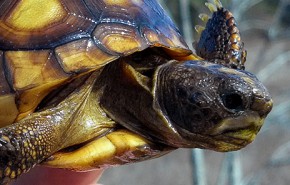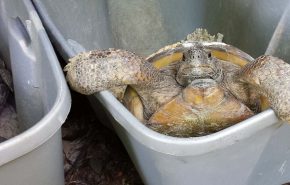Lotspeich and Associates (L&A) joined GAI Consultants (GAI) in January 2013 to add their 32 years of ecological expertise to GAI’s environmental science offerings in the Southeast. Gopher tortoise management is but one of the many habitat assessments, threatened and/or endangered species surveys, and species conservation plans conducted and prepared by Lotspeich|GAI.
Among the oldest living species, the gopher tortoise (Gopherus polyphemus) is so named because their durable spade-like front legs and sturdy elephant-like hind legs enable them to dig large, deep, burrows. The gopher tortoise is found throughout Florida, the southern portions of Georgia, South Carolina, Mississippi, and Alabama, and the eastern tip of Louisiana.
Considered a “keystone species” because it shares its deep burrow with more than 350 other species that use it for protection (e.g., Eastern indigo snake, Florida pine snake, Florida mouse, gopher frog, and burrowing owl), the gopher tortoise is under federal protection as a Threatened species throughout most of its range, primarily due to loss of habitat. In Florida, it is considered a state-Threatened species, where both the tortoise and its burrow are protected by the Florida Fish & Wildlife Conservation Commission (FWC).
Before developing or even clearing land that is potential gopher tortoise habitat, property owners are required to conduct surveys to determine site occupancy and population densities, and then obtain permits from the FWC before capturing all gopher tortoises on the property and relocating them—easier said than done, since a tortoise burrow can be up to 20-feet deep and 40-feet long. The width of the burrow varies by tortoise–but it is always wide enough for the tortoise to turn around in the burrow. For gopher tortoise survey, capture, and relocation activities, we turn to our ecologists and authorized agents at Lotspeich|GAI and their 32 years of habitat assessments, management plans, permitting, and threatened and endangered species surveys. A team of trained ecologists and a hydraulic backhoe is typically used for the proper removal of each tortoise from their deep underground burrow.
Capture methods can also include bucket trapping on sites where excavation is not practicable (along gas pipelines, beneath existing structures or buildings, adjacent to railroad lines or existing roadways) but daily checks for up to 28 consecutive days are required before the state determines the burrow to be uninhabited or the tortoise is captured. FWC regulations limit the timing of surveys (daytime temperatures above 70) as well as the timing of relocations (overnight low temperatures above 50 the night of the relocation and two nights thereafter). Given the tortoise’s sensitivity to exposure to cold temperatures, bucket trapping during extreme winter weather conditions (below 50) is not an option.
Excavation requires gently backhoe-scooping dirt a safe distance from around the burrow a few inches at a time, stopping so the ecologist can climb in and hand dig to clear the burrow and follow its often-winding path downward—if a tortoise is located, it is skillfully retrieved by hand. Excavating burrows by backhoe and hand-shovel is preferred because capture time is reduced significantly over the bucket-trapping method, meaning safe capture and same-day relocation. Either way, the first priority is to protect the gopher tortoise and to contribute to its long-term survival. For Phase I of Central Florida’s new commuter rail—SunRail–Lotspeich|GAI conducted population surveys and live-capture bucket trapping of more than 100 individual gopher tortoise burrows along the proposed rail corridor. They also developed a protection plan for the Eastern indigo snake, investigated bald eagle nests, and conducted manatee protection observations during reconstruction of the bridge over the St. Johns River.
Since gopher tortoises prefer the well-drained sandy upland areas common to Florida, we expect we’ll be seeing more “survey, capture, and relocate,” along with other ecological studies by Lotspeich|GAI. Lotspeich|GAI works with a wide diversity of clients involved with the development, management, and/or use of private property, or as part of interdisciplinary teams providing all areas of professional practice (i.e., engineers, architects, planners, etc.), including such entities as the mining, utility, and water supply/treatment industries. The firm also serves as prime consultant for state and federal entities, including the U.S. Army Corps of Engineers; South Florida, St. Johns River, and Suwannee River Water Management Districts; Florida Fish and Wildlife Conservation Commission; Florida Department of Environmental Protection; Florida Department of Transportation; and counties and cities throughout the state.
Other habitat assessments, threatened and/or endangered species surveys and management plans, and the required permitting for impacting critical habitat conducted by Lotspeich|GAI include the southern bald eagle, red-cockaded woodpecker, Florida scrub-jay, sand skink, sandhill cranes, Florida black bear, Puerto Rican boa constrictor, and a variety of sea grasses.
“It is exciting to know that we can help to save this most important species while also assisting our clients in achieving their development objectives” says Karl Lotspeich, Senior Director of Environmental Services.



